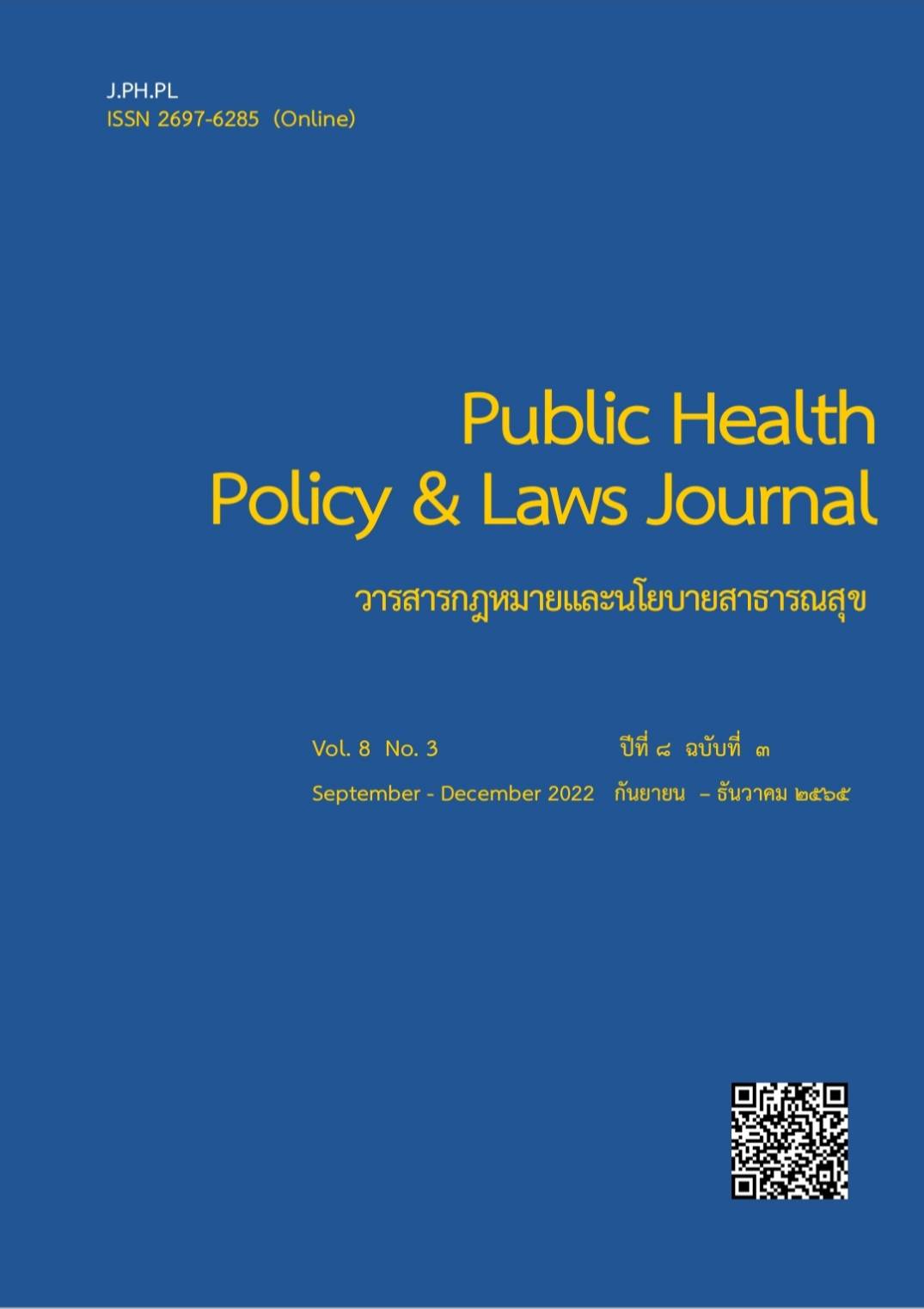Impact from COVID-19 to the changing of Thai health system
Keywords:
COVID-19, opportunity for health system development, Strategy, Health personnel, Health systemAbstract
This academic paper presents opportunities for health system development amid the COVID-19 pandemic in Thailand in three areas: the COVID-19 epidemic in Thailand, the impact of COVID-19, and the model of medical services. It was found that COVID-19 started in Thailand since January 2020 until now. This crisis has greatly affected the Thai health system such as risk to healthcare workers, shortage of healthcare workers and medical supply, increase in health care financing, and changing health needs of the people. Moreover, all of them become an important factor in accelerating changes and developments in public health as can be seen from changes in public health awareness, and the increase in various technologies in the daily life of the people. Therefore, in light of the COVID-19 crisis, it is an opportunity for the public health system to be upgraded and expanded the potential of better health services to meet the changing health needs of the people: by improving health system to prepare for future pandemics; using of appropriate technology in healthcare; and reducing unnecessary hospital visits.
References
Hafeez Abdul, Ahmad Shmmon, Siddqui Sameera Ali, Ahmad Mumtaz, Mishra Shruti. (2020) A review of COVID-19 (Coronavirus Disease-2019) diagnosis, treatments, and prevention. EJMO.4(2):116-25.
Johns Hopkins Center for Health Security. (2021) GHS INDEX Global health security index. United States: Johns Hopkins Center for Health Security.
Steve Thomas AS, James Larkin, Josep Figueras, Marina Karanikolos. (2020) Strengthening health systems resilience Key concepts and strategies. Denmark.
World Health Organization. (2021) Timeline: WHO's COVID-19 response 2021 [updated January 25,2021; Accessed January 25, 2022]. https://www.who.int/emergencies/diseases/novel-coronavirus-2019/interactive-timeline#!
World Health Organization. (2020) Pneumonia of unknown cause – China 2020 [Accessed January 25, 2022]. https://www.who.int/emergencies/disease-outbreak-news/item/2020-DON229.
World Health Organization. (2010) Telemedicine Opportunities and developments in Member states. Geneva: World Health Organization.
World Health Organization. (2021) Building health systems resilience for universal health coverage and health security during the COVID-19 pandemic and beyond. Geneva: World Health Organization.
World Health Organization. (2015) WHO global strategy on people-centred and integrated health services Interim Report. Geneva: World Health Organization.
กระทรวงสาธารณสุข. (26 กุมภาพันธ์ 2563). ประกาศกระทรวงสาธารณสุข (ฉบับที่ 3) พ.ศ. 2563 เรื่อง ชื่อและอาการสำคัญของโรคติดต่ออันตราย. ฉบับประกาศทั่วไป เล่มที่ 137, ตอนพิเศษ 48 ง.
กองยุทธศาสตร์และแผนงาน สำนักงานปลัดกระทรวงสาธารณสุข. (2564) ยุทธศาสตร์การจัดการการระบาดของโรคติดเชื้อไวรัสโคโรนา 2019 (COVID-19) ระลอกใหม่. พิมพ์ครั้งที่ 1. นนทบุรี: บริษัท รับพิมพ์ จำกัด.
กองโรคติดต่อทั่วไป กรมควบคุมโรค กระทรวงสาธารณสุข. (2564) สถานการณ์โรคติดเชื้อไวรัสโคโรนา 2019 (COVID-19) มาตรการสาธารณสุข และปัญหาอุปสรรคการป้องกันควบคุมโรคในผู้เดินทาง. นนทบุรี: กระทรวงสาธารณสุข.
กรมการแพทย์. (3 พฤศจิกายน 2563). ประกาศกรมการแพทย์ เรื่อง แนวทางปฏิบัติการปรับรูปแบบบริการการบริการดูแลรักษาผู้ป่วยนอก (OPD) ในสถานการณ์การระบาดของโรคติดเชื้อไวรัสโคโรนา 2019.
กรมวิทยาศาสตร์การแพทย์. (2563) การส่งN95เพื่อรมฆ่าเชื้อด้วยไอไฮโดรเจนเปอร์ออกไซด์ เพื่อนำกลับมาใช้ซ้ำ. กรมวิทยาศาสตร์การแพทย์.
จุฬาลงกรณ์มหาวิทยาลัย. วิศวฯ จุฬาฯ ส่งหุ่นยนต์ “ปิ่นโต” ช่วยแพทย์และพยาบาล กู้วิกฤติ COVID-19 รอบใหม่ทั่วประเทศ 2563 [ปรับปรุงเมื่อ 28 ธันวาคม 2563; เข้าถึงเมื่อ10 เมษายน 2565]. https://www.chula.ac.th/news/37194/.
เจะซานารียะ หะยีเจะซอ. (2563) โครงการ อสม. “Grab Drug” ส่งยาโรคเรื้อรังถึงมือถึงบ้านผู้ป่วย. โรงพยาบาลส่งเสริมสุขภาพตำบลเตราะบอน.
ฐิติกร โตโพธิ์ไทย, รุ่งทิวา มากอิ่ม, ชมพูนุท โตโพธิ์ไทย. (2563) บทเรียนจากการป้องกันและควบคุมการระบาดของโควิด-19: กรณีศึกษาเทศบาลเมืองอ่างทอง. วารสารวิจัยระบบสาธารณสุข.14:489-507.
บุษกร โลหารชุน. (2564) ต้นแบบโรงพยาบาลสนามโควิด 19 เพื่อคนพิการ. วารสารกรมการแพทย์. 46(3):5-10.
ปิยะวัฒน์ รัตนพันธุ์, ประดับ เพ็ชรจรูญ, สิรินยา สุริยา. (2563) การพัฒนาระบบจัดส่งยาทางไปรษณีย์สำหรับผู้ป่วยโรคความดันโลหิตสูง ในสถานการณ์แพร่ระบาดของเชื้อไวรัสโคโรนาสายพันธุ์ใหม่ 2019. เชียงรายเวชสาร. 12(2):48-66.
สำนักงานพัฒนาวิทยาศาสตร์และเทคโนโลยีแห่งชาติ. ‘MagikTuch’ ปุ่มกดลิฟต์ไร้สัมผัส นวัตกรรมลดการระบาดเชื้อโควิด-19 2565 [ปรับปรุงเมื่อ 27 มกราคม 2565; เข้าถึงเมื่อ 10 เมษายน 2565]. https://www.nstda.or.th/home/news_post/magiktuch-20220127/.
สำนักนายกรัฐมนตรี. (12 มีนาคม 2563). คำสั่งสำนักนายกรัฐมนตรี ที่ 76/2563 เรื่อง จัดตั้งศูนย์บริหารสถานการณ์การแพร่ระบาดของโรคติดเชื้อไวรัสโคโรนา 2019 (โควิด – 19).
สถาบันรับรองคุณภาพสถานพยาบาล (องค์การมหาชน). (2564) Towards Scaling – up and Resilience in Healthcare. นนทบุรี: สถาบันรับรองคุณภาพสถานพยาบาล (องค์การมหาชน).
ศูนย์สำรวจความคิดเห็นนิด้าโพล. (2563) รายงานฉบับสมบูรณ์ ผลการสำรวจข้อมูลและความต้องการของผู้มีส่วนได้ส่วนเสียกรมการแพทย์ในโครงการพัฒนาการบริการทางการแพทย์วิถีใหม่ (New Normal of Medical Service) ในสถานพยาบาลแต่ละระดับ จังหวัดปัตตานี.กรุงเทพมหานคร: ศูนย์สำรวจความคิดเห็นนิด้าโพล.
องค์การอนามัยโลก (WHO) ประเทศไทย. (2563) การวิเคราะห์สถานการณ์ รายงานสถานการณ์โรคไวรัสติดเชื้อโคโรนา2019 (โควิด-19) 12 มีนาคม 2563. นนทบุรี: องค์การอนามัยโลก (WHO) ประเทศไทย.
องค์การอนามัยโลก (WHO) ประเทศไทย. (2563) รายงานสถานการณ์โรคไวรัสติดเชื้อโคโรนา 2019
(โควิด-19) 26 มีนาคม 2563. นนทบุรี: องค์การอนามัยโลก (WHO) ประเทศไทย.
อนุตรา รัตน์นราทร. (2564) รายงานผู้ป่วยโรคติดเชื้อไวรัสโคโรนา 2019 (COVID-19) : ผู้ป่วยรายแรกของประเทศไทยและนอกประเทศจีน. วารสารสถาบันบำราศนราดูร. 14(2):116–23.
Downloads
Published
How to Cite
Issue
Section
License
Disclaimer and Copyright Notice
The content and information presented in articles published in the Journal of Law and Public Health Policy represent the opinions and sole responsibility of the respective authors. The editorial board does not necessarily agree with or assume any responsibility for the views expressed.
All articles, data, content, images, and other materials published in the Journal of Law and Public Health Policy are the intellectual property of the journal. Any individual or organization wishing to reproduce, distribute, or otherwise use the entirety or any part of such materials must provide proper citation.





